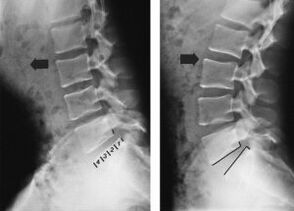Osteochondrosis of the cervical and thoracic spine is diagnosed less often than other forms of this pathology. This is due to the anatomical features of the structure of the human mid-back. The intervertebral discs in this area move quite a bit. However, this abnormality still occurs occasionally and requires appropriate therapy.
Characteristics of the disease.
This term is understood as dystrophic and degenerative changes in the spine, leading to abnormalities in the structure of cartilage and bone tissues. According to ICD-10, the pathology is coded as follows: M42. Osteochondritis of the spine.
If you do not immediately begin treatment of the disease, there is a risk of violation of the structure of the ligamentous apparatus, joints and intervertebral discs. Often osteochondrosis leads to atherosclerosis, malignant tumors, infertility and other disorders.
stages
Depending on the level of destruction of the vertebrae, several stages of the development of the disease are distinguished:
- In the disease of the first degree, the discs lose their elasticity, their height decreases. Sometimes bumps or bumps form.
- Osteochondrosis of the second degree is accompanied by a further decrease in the height of the discs and the loss of their elasticity. Instability of the thoracic region appears at this stage. This worsens a person's condition and can lead to a fissure in the annulus of the disc. This violation is fraught with the appearance of a hernia. At this stage, pain occurs. Neurological manifestations may also be present.
- For osteochondrosis of the third degree, the appearance of intervertebral hernias is characteristic. Symptoms of pathology depend on the size and localization of this formation.
- Fourth degree disease is accompanied by a loss of the cushioning characteristics of the discs. At this stage, there is a convergence of the vertebrae, loss of mobility of the spine, pinching of blood vessels and nerves. This form of the disease is characterized by the destruction of the bones of the spine.
The reasons
Thoracic osteochondrosis is most often caused by a lack of physical activity. This leads to a weakening of muscle tissue and leads to an increased load on the intervertebral discs.
Also, the causes of pathology include the following:
- bad habits;
- posture disorders;
- genetic predisposition;
- hypodynamia;
- Increased physical activity;
- spinal cord injuries;
- stressful situations.
Symptoms

This form of osteochondrosis has less pronounced manifestations than other types of this disease. Characteristic symptoms of pathology include the following:
- chest pains that increase at night due to a long stay in an uncomfortable position, with hypothermia and increased stress;
- discomfort between the shoulder blades that occurs when lifting the limbs or bending;
- increased discomfort with deep inhalations and exhalations;
- pain between the ribs that occurs when moving;
- tightness in the chest area.
With an exacerbation of the pathology, the pain syndrome is present for several weeks. In addition, there are additional manifestations of the thoracic form of the disease:
- loss of sensitivity of some areas of the skin, appearance of goosebumps;
- burning and itching sensation, coldness in the lower extremities;
- brittleness of the nails and peeling of the skin;
- pain in the esophagus and pharynx;
- violations of the functions of the digestive organs.
How to treat thoracic osteochondrosis
To deal with this violation, you must provide an integrated approach. The doctor must select specific methods of therapy, taking into account the clinical picture of the disease.
Medically
In the chest form of the disease, the following categories of drugs are most often used:
- Anti-inflammatory medications. They help to cope with pain and eliminate swelling of soft tissues. With intercostal neuralgia, local dosage forms are prescribed in the form of ointments and creams.
- anestheticsInjected into the spine to relieve pain and muscle spasm.
- Muscle relaxants. Such remedies eliminate painful muscle spasm.
- Antidepressants. These drugs eliminate the psychoemotional stress that often accompanies osteochondrosis.
- B vitamins. Such drugs provide nutrition to nerve fibers. This helps to cope with neurological abnormalities. In the treatment of osteochondrosis, agents containing vitamins B1, B6 and B12 are used.
- Chondroprotectors. Such funds help to stop the destruction of the discs and normalize bone metabolism. It is recommended to inject them directly into the paravertebral tissues.
exercise therapy and physical therapy

With the help of therapeutic exercises and gymnastics, you can reduce the frequency of exacerbations. To do this, it is recommended to perform the following movements:
- Sit in a chair, put your hands behind your head, inhale. As you exhale, contract your shoulder blades. Do 10-15 repetitions.
- Get on all fours, gently arch your back, and stay in that position. After a few seconds, lean up and look at this position again. Do 15-20 repetitions.
- Lie on your back, raise your legs straight 20-30 cm, stay in this position for 20 seconds. Do 10 repetitions.
Physiotherapy is an effective method of therapy. They have a local effect on the focus of pathology.
Thanks to the exercises, it is possible to cope with pain and spasms, improve tissue nutrition and normalize blood circulation. In the thoracic form of the pathology, magnetotherapy, laser exposure and electrophoresis are indicated.
popular recipes
When choosing home remedies, be sure to take into account the degree of the disease and the symptoms present. If the disease has an acute course and is accompanied by severe pain, then therapy begins with anti-inflammatory and analgesic preparations.
The following plants have this effect:
- chamomile;
- wise;
- viburnum;
- elecampane;
- Birch.
These plants can be prepared as regular tea. To do this, take 1 tablespoon for every 250 ml of boiling water. Take the composition of 1 glass 2-3 times a day. To improve the taste of the drink, you can add a little honey to it.
What to do during an exacerbation
With an exacerbation of thoracic osteochondrosis, the following recommendations should be observed:
- reduce physical activity - it is better to observe bed rest;
- eat properly;
- take medications prescribed by a doctor;
- give yourself a gentle self-massage and rub the problem areas;
- participate in therapeutic exercises if indicated;
- rubbing creams and ointments recommended by the doctor;
- use physiotherapy.
Complications and consequences
If you do not start therapy on time, there is a risk of developing dangerous consequences. These include the following:
- intervertebral protrusion and hernia;
- spinal cord compression;
- deviations in the work of internal organs: heart, liver, intestines, kidneys, pancreas;
- duodenal injuries, intestinal motility disorders, gallbladder dyskinesia;
- Intercostal neuralgia: irritation or compression of the nerve fibers.
Prevention and prognosis
To avoid the occurrence of thoracic osteochondrosis, it is necessary to follow these recommendations:
- avoid a static position of the body: warm up periodically;
- choose a comfortable work chair;
- sleep on an orthopedic mattress;
- refuse to carry heavy objects;
- control body weight;
- engage in physical therapy.
It is impossible to completely cure the disease, but you can stop its development. Provided the timely start of therapy, the pathology has a favorable prognosis.
Thoracic osteochondrosis is a serious disease that is accompanied by severe pain and can lead to dangerous health consequences. To cope with this violation, it is necessary to consult a doctor in time.



















